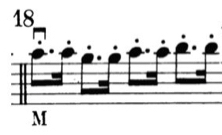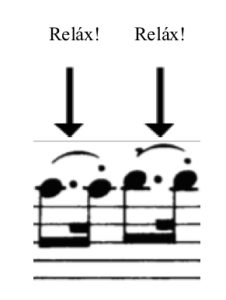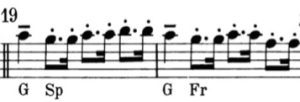Part 9 – Feuillard No. 32 – Variations #18-21
Today’s blog is devoted entirely to dotted rhythms, building on the elements of Variation #8 that we had encountered earlier on the page in Feuillard No. 32. As I mentioned in that earlier discussion, dotted rhythms are notoriously difficult for string players. We tend to play triplets instead of the correct dotted rhythm.
This is an example of how logically and well organized Mr. Feuillard’s exercises are presented. The one dotted rhythm example earlier in No. 32 helped Caroline to become familiar with the basic issues involved in playing this rhythm. Now that the fundamentals are more secure, a few weeks later, Feuillard adds complexity. There will be more dotted rhythms coming up in No. 33, which will again add to the mix.
Variation #18:

Another problem for cellists in playing dotted rhythms is that we tend to get physically tired from the “exertion” that is involved in producing this stroke. The solution to this part of the problem is to train ourselves to relax physically during the subdivided beat. I find it useful to ask the students to say the word “relax” in a rhythmical way – this helps with the subdivision and it also helps with relaxing the arm. It is an interesting coordination exercise, but once the students can say the word “relax”, with the “láx” syllable on the subdivision, then the next step is to really relax the muscles while saying the word and playing the notes. This exercise helps to train the physical release of the muscles.

The idea is to consciously relax the muscles of the arm during the longer note, and then to come back into the string in order to articulate the shorter note. This takes a good amount of training, concentration, and repetition to internalize all the elements – but it is worth the time and effort to have this tool in our technical toolbox.
No. 32 Variation #18:
One other concept that I like to discuss with the students at this point is “double-dotting”. Most of the younger students are not familiar with this stylistic feature of the Baroque, and it is time to acquaint them with it. I also want the students to start listening to lots of literature, so I usually ask them to find some recordings of double-dotting in performances of pieces by Lully, Couperin and Rameau.
Double-Dotting:
Many years ago I started working with a talented student who was then in the fifth grade, Wade Davis. I presented the idea of “double-dotting” and asked him if he was aware of this concept. He said “of course”, and proceeded to give me a lecture on the French Baroque, the French overture style, Lully, Couperin and Rameau, and the Bach Fifth Suite. He later went on to the North Carolina School of the Arts, and Peabody – and specializes now as a Baroque cellist. Who would have predicted that…? You can visit Wade’s website at: wadedaviscello.weebly.com
Variation #19:

This variation is more complex by adding some other elements, including bow distribution, contact point issues, and being able to make the same kind of sound at the frog and the tip. Caroline and I worked quite a bit on this variation, tearing it apart and then putting it together again. I asked her to repeat it the next week, and she improved it a lot.
No. 32 – Variation #19:
Variations #20-21

As you have seen in previous blogs, I ask the students to write in their tempos for each variation (and for etudes and pieces) while they are working on them at home. This helps me know if they are thinking about the tempos in a healthy way, and helps me address issues of rhythm and pulse. It is also a good way to maintain consistency between the practice sessions and the lesson. If a student comes in playing a variation (or an etude or piece) at a tempo that is too fast for them to handle, I can check to see if they are just being nervous, or if they were playing too fast because they were conceiving the tempo at that speed.
In the case of Caroline’s Variation #20 I wanted her to feel the larger pulse of the quarter note rather than the smaller pulse of the eighth note:
No. 32 – Variation #20 and #21:
I was especially impressed with Caroline’s #21 because that variation is particularly difficult for most people, and I usually expect that it will take a few lessons to get it right. When Caroline played it correctly on the first try I wanted to give her my signature “handshake” for having succeeded in something really well.
As I work with the students on all these Feuillard exercises I am interested in knowing how they feel about what we are doing. Some students seem to love doing this detailed and intense work. Others find it “boring” or don’t understand the need for it. In any case, I like to find out what they are thinking about their work on the Feuillard and then discuss it with them. In Caroline’s case, she is making good progress, but I wasn’t sure if she enjoys this work or not. So, I asked her:
Caroline and Mr. Feuillard:
In the next Blog we will work with the specialty strokes in Variations #22-26: up-bow staccato and sautillé.
*If you have questions or comments about The Joy of Feuillard, Dr. Robert Jesselson can be reached directly at rjesselson@mozart.sc.edu.














